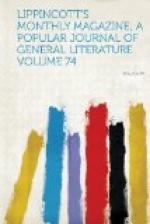that pleasant summer afternoon, and from the time we
got out of the carriage until the moment we re-entered
it—all too soon, but it is a long drive
back in the short cold twilight—I felt
as though I had stepped through a magic portal
into the scene of one of Washington Irving’s
stories. It was all so simple and homely,
so quaint and so inexpressibly picturesque.
The house had stood there for a couple of hundred
years, and looks as though it might last for ever,
with its air of cool, leisurely repose and comfort
and strength.
In the flagged hall stands a huge stalactite some ten feet high, brought a hundred years ago from caves far away in the distant ranges. It is shaped something like a Malay’s hat, only the peak tapers to a point about eight feet high. The drawing-room—though it seems a profanation to call that venerable stately room by so flippant and modern a name—is large, ceiled with great beams of cedar, and lighted by lofty windows, which must contain many scores of small panes of glass. There were treasures of rarest old china and delfware, and curious old carved stands for fragile dishes. A wealth of swinging-baskets of flowers and ferns and bright girl-faces lighted up the solemn, shady old room, in which we must not linger, for there is much to see outside. First to the cellar, as it is called, though it is far from being under ground, and is, in fact, a spacious stone building with an elaborately-carved pediment. Here are rows and rows of giant casks, stretching on either hand into avenues in the black distance, but these are mere children in the nursery, compared to those we are going to see. First we must pause in a middle room full of quaintest odds and ends—crossbows, long whips of hippopotamus hide, strange rusty old swords and firearms—to look at a map of South Africa drawn somewhere about 1640. It hangs on the wall and is hardly to be touched, for the paint and varnish crack and peel off at a breath. It is a marvel of accurate geographical knowledge, and is far better filled in than the maps of yesterday. All poor Livingstone’s great geographical discoveries are marked on it as being—perhaps only from description—known or guessed at all that long time ago. It was found impossible to photograph it on account of the dark shade which age has laid over the original yellow varnish, but a careful tracing has been made and, I believe, sent home to the Geographical Society. It is in the long corridor beyond this that the “stuck-vats” live—puncheons which hold easily some thousand gallons or so, and are of a solemn rotundity calculated to strike awe into the beholder’s heart. Here is white constantia, red constantia, young constantia, middle-aged constantia, and constantia so old as to be a liqueur almost beyond price. When it has been kept all these years, the sweetness by which it is distinguished becomes so absorbed and blended as to be hardly perceptible.
Presently one of the party throws a




